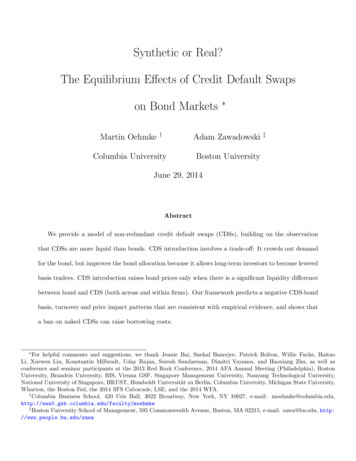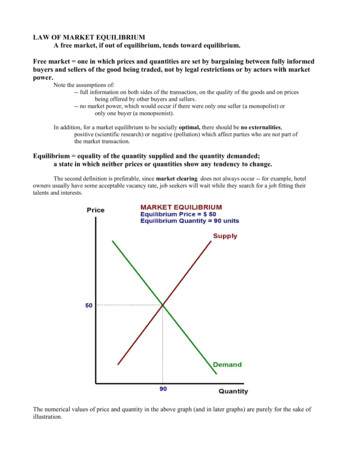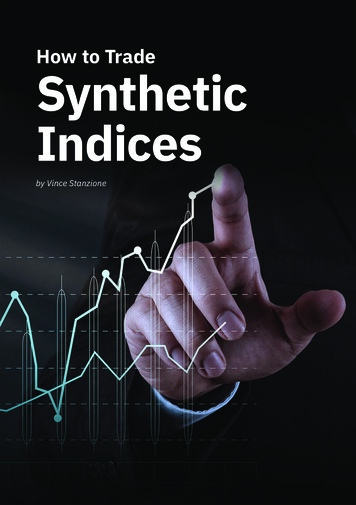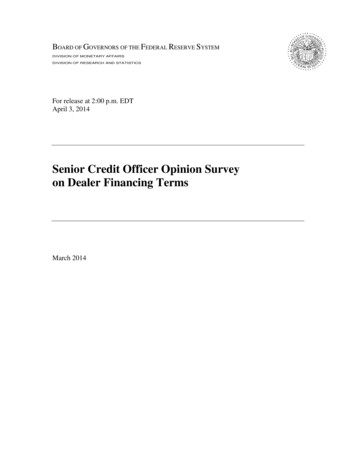
Transcription
Synthetic or Real?The Equilibrium Effects of Credit Default Swapson Bond MarketsMartin Oehmke† Adam ZawadowskiColumbia University‡Boston UniversityJune 29, 2014AbstractWe provide a model of non-redundant credit default swaps (CDSs), building on the observationthat CDSs are more liquid than bonds. CDS introduction involves a trade-off: It crowds out demandfor the bond, but improves the bond allocation because it allows long-term investors to become leveredbasis traders. CDS introduction raises bond prices only when there is a significant liquidity differencebetween bond and CDS (both across and within firms). Our framework predicts a negative CDS-bondbasis, turnover and price impact patterns that are consistent with empirical evidence, and shows thata ban on naked CDSs can raise borrowing costs. For helpful comments and suggestions, we thank Jennie Bai, Snehal Banerjee, Patrick Bolton, Willie Fuchs, HaitaoLi, Xuewen Liu, Konstantin Milbradt, Uday Rajan, Suresh Sundaresan, Dimitri Vayanos, and Haoxiang Zhu, as well asconference and seminar participants at the 2013 Red Rock Conference, 2014 AFA Annual Meeting (Philadelphia), BostonUniversity, Brandeis University, BIS, Vienna GSF, Singapore Management University, Nanyang Technological University,National University of Singapore, HKUST, Humboldt Universität zu Berlin, Columbia University, Michigan State University,Wharton, the Boston Fed, the 2014 SFS Calvacade, LSE, and the 2014 WFA.†Columbia Business School, 420 Uris Hall, 3022 Broadway, New York, NY 10027, e-mail: faculty/moehmke‡Boston University School of Management, 595 Commonwealth Avenue, Boston, MA 02215, e-mail: zawa@bu.edu, http://www.people.bu.edu/zawa
1IntroductionCredit Default Swap (CDS) markets have grown enormously over the last decade. However, whilethere is a relatively large literature on the pricing of CDSs, much less work has been done on theeconomic role of these markets. For example, in most pricing models, CDSs are redundant securities,such that the introduction of a CDS market has no effect on the underlying bond market. Thisirrelevancy feature makes a meaningful analysis of the economic role of CDS markets difficult.In this paper, we develop a theory of non-redundant CDS markets, building on a simple, welldocumented empirical observation: Trading bonds is expensive relative to trading CDSs. Based onthis observation, we develop a theory of the interaction of bond and CDS markets and the economicrole of CDSs. Our model provides an integrated framework that matches many of the stylized factsin bond and CDS markets: the effect of CDS markets on the price of the underlying bond (andtherefore financing cost for issuers), the relative pricing of the CDS and the underlying bond (theCDS-bond basis), and trading volume in the bond and CDS markets. Our model also provides atractable framework to assess policy interventions in CDS markets, such as the recent E.U. ban ofnaked CDS positions.In our model, investors differ across two dimensions. First, investors differ in their investmenthorizons: Some investors are unlikely to have to sell their position in the future and are therefore similarto buy-and-hold investors, such as insurance companies. Other investors are more likely to receiveliquidity shocks and therefore have shorter investment horizons. These investors can be interpretedas active traders, such as speculators or hedge funds. Second, investors have heterogeneous beliefsabout the bond’s default probability: Optimistic investors view the default of the bond as unlikely,while pessimists think that a default is relatively more likely. If only the bond is traded, relativelyoptimistic investors with sufficiently long trading horizons buy the bond, whereas relatively pessimisticinvestors with sufficiently long trading horizons take short positions in the bond. Investors with short1
investment horizons stay out of the market, because for them the transaction costs of trading thebond are too high.The introduction of a CDS affects the underlying bond market through three effects: (1) Someinvestors who previously held a long position in the bond switch to selling CDS protection, puttingdownward pressure on the bond price. (2) Investors who previously shorted the bond switch to buyingCDS protection because, in equilibrium, the relatively illiquid bond trades at a discount comparedto the CDS. The resulting reduction in short selling puts upward pressure on the bond price. (3)Some investors become “negative basis traders” who hold a long position in the bond and purchaseCDS protection (i.e., the model endogenously generates the negative basis trade, which has been animmensely popular trading strategy in recent years). If basis traders cannot take leverage, they donot affect the price of the underlying bond. If basis traders can take leverage—a natural assumptiongiven that they hold hedged positions—they push up the bond price. In practice, basis trades areoften highly levered and their leverage varies with financial conditions, leading to time-series variationin the strength of this third effect.Taken together, these three effects imply that, in general, CDS introduction is associated with anambiguous change in the price of the underlying bond. This prediction is consistent with the empiricalliterature, which has found no unconditional effect of CDS introduction on bond or loan spreads (Hirtle(2009), Ashcraft and Santos (2009)). More importantly, our model identifies the underlying economictrade-off that determines the effect of CDS introduction. One the one hand, CDS introduction cancrowd out demand for the bond, while on the other hand it leads to an allocational improvement inthe bond market, because the presence of the CDS allows long-term investors to hold more of thebond supply. The balance of this trade-off critically depends on the relative liquidity of the bondand the CDS: When the bond and the CDS are similar in terms of their liquidity, the crowdingout effect dominates and CDS introduction lowers bond prices. On the other hand, when there is asubstantial difference in the liquidity of the CDS and the underlying bond, the introduction of theCDS tends to raise bond prices. The same logic implies that, for firms with multiple bond issues of2
differing liquidity (e.g., “on-the-run” and “off-the-run” bonds), illiquid bonds benefit relatively morefrom CDS introduction. In fact, the price effect of CDS introduction can go in opposite directions forbonds of differing liquidity issued by the same company; the price of the illiquid bond increases whilethe price of the liquid bond decreases.The endogenous emergence of leveraged basis traders highlights a novel economic role of CDSmarkets: The introduction of a relatively more liquid derivative market allows buy-and-hold investors,who are efficient holders of the illiquid bond, to hedge undesired credit risk in the more liquid CDSmarket. In the CDS market, the average seller of CDS protection is relatively optimistic about thebond’s default probability, but is not an efficient holder of the bond because of more frequent liquidityshocks. The role of CDS markets is thus similar to liquidity transformation—by repackaging thebond’s default risk into a more liquid security, they allow the transfer of credit risk from efficientholders of the bond to relatively more optimistic shorter-term investors, such as hedge funds. Hence,when bonds are illiquid, a liquid CDS can improve the allocation of credit risk and thus presents analternative to recent proposals that aim at making the corporate bond market more liquid, for examplethrough standardization.1 This liquidity view of CDS markets differs from the traditional view thatthe main function of CDSs is simply the separation of credit risk and interest rate risk.2 However,because the separation of interest rate risk from credit risk is also possible via a simple interest rateswap, it is unlikely that this traditional view captures the full economic role of CDS markets.Beyond the price effects of CDS introduction, our model generates testable predictions regardingtrading volume in bond and CDS markets that are consistent with recent empirical evidence. First, ourmodel predicts that CDS turnover is higher than bond turnover, which is consistent with the evidencein Oehmke and Zawadowski (2013), who show that average monthly CDS turnover is around 50%,whereas average monthly turnover in the associated bonds is around 7.5%. Second, consistent with thefindings of Das, Kalimipalli, and Nayak (2014), our model predicts that CDS introduction decreasesturnover in the underlying bond. Third, despite this decrease in turnover, CDS introduction can reduce12Standardized bonds were recently proposed by the investment management firm BlackRock (BlackRock (2013)).See, e.g., the “Credit Derivatives Handbook” (JPMorgan (2006)).3
price impact in the bond market, such that, consistent with Das, Kalimipalli, and Nayak (2014), theeffect of CDS introduction on bond market liquidity can differ depending on which particular illiquiditymeasure is used.From an asset pricing perspective, the prediction that the equilibrium price of the bond is (weakly)less than the price of a synthetic bond consisting of a risk-free bond and a short position in the CDSreplicates a well-documented empirical phenomenon known as the negative CDS-bond basis (see,e.g., Bai and Collin-Dufresne (2010) and Fontana (2011)). Here our model generates a number ofpredictions regarding both the time-series and cross-sectional variation in the CDS-bond basis: Thebasis is more negative if the bond is more illiquid, when there is more disagreement about the bond’sdefault probability, and when basis traders are restricted in the amount of leverage they can take.Finally, our model provides a framework to study regulatory interventions with respect to CDSmarkets. For example, a ban on naked CDS positions, as recently imposed by the European Union onsovereign bonds through EU regulation 236/2012, may, in fact, raise yields for affected issuers. Thiscan happen because, if pessimistic investors cannot take naked CDS positions, some of them will shortthe bond instead. This exerts downward price pressure on bond prices: Due to the liquidity differencebetween bonds and CDSs, naked CDS positions and short bond positions are not equivalent becausea different set of investors takes the other side.3Our paper contributes to a growing literature on derivatives as non-redundant securities.4 In ourframework, the source of non-redundancy is a difference in the market liquidity of the underlyingsecurity and the derivative, which we model using the classic framework of Amihud and Mendelson(1986). Given the well-documented illiquidity of corporate bonds, we view liquidity as a source of nonredundancy to be particularly important in the context of the CDS market. Other contributions tothis literature have focused on different (and potentially complementary) sources of non-redundancy,3In addition to the naked CDS ban, we also briefly explore the effects of banning CDS markets altogether and banningboth CDS markets and short positions in the underlying bond. In general, also these interventions have ambiguous effectson bond yields.4Hakansson (1979) provides an early discussion of why derivatives should be studied in settings where they are notredundant.4
including market incompleteness (Detemple and Selden (1991)), the informational effects of derivativemarkets (Grossman (1988), Biais and Hillion (1994), Easley, O’Hara, and Srinivas (1998), and Goldstein, Li, and Yang (2014)), the possibility that derivatives generate sunspots (Bowman and Faust(1997)), and changes in the relative bargaining power of debtors and creditors (Bolton and Oehmke(2011), Arping (2014)).In addition, a number of recent papers have investigated the role of derivatives in the presence ofshort-sale and collateral constraints. Banerjee and Graveline (2014) show that derivatives can relaxbinding short-sales constraints when the underlying security is scarce (i.e., on “special”). Fostel andGeanakoplos (2012) show that, in the presence of collateral constraints in the spirit of Geanakoplos(2010) and Simsek (2013), the introduction of CDSs can lead to financial busts because they allowpessimistic investors to bet more effectively against the underlying asset. Che and Sethi (2013) showthat naked CDSs facilitate leveraged negative bets that can increase a firm’s cost of capital. Incontrast to these papers, our approach does not rely on explicit short-sale or collateral constraints (ortheir relaxation). This means, for example, that our framework applies also in situations where theunderlying asset can be shorted relatively easily.5 Gârleanu and Pedersen (2011) explore the relativepricing of derivatives and underlying assets when derivatives have lower margin requirements and applythis framework to the CDS-bond basis. Shen, Yan, and Zhang (2013) develop a model of financialinnovation based on differences in collateral requirements. However, these papers do not focus on theconsequences of derivative introduction on the underlying asset, which is the main focus of our paper.While, leaning on empirical evidence, we take the difference in market liquidity between the CDSand the underlying bond as given, a number of search-theoretic models have explored endogenousdifferences in liquidity between assets with identical payoffs (Vayanos and Wang (2007), Vayanos andWeill (2008), Weill (2008)). In this context, Praz (2013) studies the interaction between a (liquid)5In contrast to some markets where short selling is indeed difficult to impossible, this feature of our model may be relevantwhen it comes to corporate bond markets: Asquith, Au, Covert, and Pathak (2013) document that shorting costs in thecorporate bond market are modest on average and comparable to those in the stock market.5
Walrasian and a (less liquid) OTC market, while Sambalaibat (2013) studies the effect of naked CDStrading in search markets.More generally, our paper contributes to a growing literature on the economic effects of CDS markets. Duffee and Zhou (2001), Morrison (2005), Parlour and Plantin (2008), Parlour and Winton(2013), and Thompson (2009) explore how CDS markets allow banks to lay off credit risk and affectfunding and monitoring outcomes. Allen and Carletti (2006) investigate how the availability of CDSsaffects financial stability. Yorulmazer (2013) develops a model of CDSs as a means of regulatory arbitrage. Zawadowski (2013) develops a model in which CDSs are used to hedge counterparty exposuresin a financial network. Atkeson, Eisfeldt, and Weill (2012) provide a model of the market structure ofCDS and other OTC derivative markets. Overviews of CDS markets and current policy debates canbe found in Stulz (2010), Jarrow (2011), and Bolton and Oehmke (2013).62Model SetupWe consider a financial market with (up to) two assets: (i) a defaultable bond and (ii) a CDS thatreferences the bond. The main assumption of our model is that the bond and the CDS, which offerexposure to the same credit risk, differ in liquidity. This difference in liquidity makes the CDS nonredundant.7Illiquidity and high transaction costs in the corporate bond market have been widely documented.8In contrast, CDS markets tend to be relatively liquid. In fact, it has become standard in the asset6There is also a growing empirical literature on price discovery in CDS markets (Acharya and Johnson (2007), Hilscher,Pollet, and Wilson (2014)), the effect of CDSs on leverage and maturity (Saretto and Tookes (2013)), the determinants ofCDS market existence and CDS positions (Oehmke and Zawadowski (2013)), the CDS-bond basis (Blanco, Brennan, andMarsh (2005), Bai and Collin-Dufresne (2010), Fontana (2011), Li, Kim, and Zhang (2010)).7This liquidity view of CDS markets echoes Ashcraft and Santos (2009) who, in their empirical study of the effects ofCDS introduction, point out that “Liquidity in the bond market has been limited because many investors hold their bondsuntil maturity. The secondary market for loans has experienced rapid growth in the recent years, but bank loans remainlargely illiquid. Under these circumstances, the development of the CDS market provided banks and investors with a new,less expensive, way to hedge or lay off their risk exposures to firms.”8See, e.g., Bessembinder, Maxwell, and Venkataraman (2006), Edwards, Harris, and Piwowar (2007), Mahanti, Nashikkar,Subrahmanyam, Chacko, and Mallik (2008), Bao, Pan, and Wang (2011). Effective trading costs for bonds include bothbid-ask spreads and the market impact of trading and are usually much larger than quoted bid-ask spreads. In a samplethat contains the most liquid bonds in the TRACE database, Bao, Pan, and Wang (2011) estimate effective trading costs forcorporate bonds to be between 74 and 221 basis points, depending on the size of the trade. Transactions costs for less liquid6
pricing literature to assume that the CDS market is perfectly liquid (see Longstaff, Mithal, and Neis(2005)).9 Following Amihud and Mendelson (1986), we model illiquidity by assuming that investorsincur trading costs, which we interpret broadly as reflecting both bid-ask spreads and market impactcosts. Our main assumption, based on the evidence discussed above, is that these trading costs arelower for the CDS than the associated bond.While we take the difference in liquidity between the bond market and the CDS market as given,a number of factors contribute to the relative liquidity of CDS markets when compared to bonds orloans. The first is standardization: The bonds issued by a particular firm are usually fragmented into anumber of different issues which differ in their coupons, maturities, covenants, embedded options, andother features. The resulting fragmentation reduces the liquidity of these bonds. The CDS market, onthe other hand, provides a standardized venue for the firm’s credit risk (for a more detailed descriptionsee Stulz (2010)). Consistent with this argument, Oehmke and Zawadowski (2013) show that, CDSmarkets are more active and more likely to exist for firms whose outstanding bonds are fragmented intomany separate bond issues. Second, a CDS investor who has to terminate an existing CDS positionprior to maturity rarely sells his CDS in the secondary market; rather than selling the original contracthe simply enters an offsetting CDS contract, which is usually cheaper. Third, inventory managementfor market makers is generally cheaper for CDS dealers than for market makers in bond markets.bonds are even higher. Very large trades ( 10M ) are hard to execute in the bond market and usually have large transactioncosts (Randall (2013)). CDS trades, on the other hand, are routinely at least 10M, which is the typical unit of trade.9While this assumption is not literally true, traders and other market participants generally view the CDS market as moreliquid than the market for the underlying bonds. Unfortunately, transaction data to calculate the effective trading costs ofCDSs is not available. However, a rough comparison of CDS and bond trading costs can be obtained by comparing CDSbid-ask spreads to effective bond trading costs. For CDSs, the bid-ask spread should capture most of the effective tradingcosts: Because CDS spreads are generally quoted for large trade sizes, market impact is less important for CDS trading coststhan for bond trading costs. To compare CDS bid-ask spreads to bond trading costs, the CDS bid-ask spread has to bemultiplied by the tenor (maturity) of the CDS. In fact, this approach likely overstates effective CDS roundtrip costs, becauseinvestors typically shop around for the best bid and ask prices, such that the roundtrip cost is the inside bid-ask spread(lowest ask minus highest bid) instead of the average bid-ask spread which is typically reported. Hilscher, Pollet, and Wilson(2014) report bid-ask spreads of 4-6 basis points for five-year credit default swaps on IG bonds, which thus implies tradingcosts of around 20-30 basis points, significantly lower than the implied spreads reported by Bao, Pan, and Wang (2011).In fact, often the liquidity advantage of CDSs can be seen by simply comparing bid-ask spreads. For example, even in thesample of sovereign bonds (which are usually relatively liquid) in Sambalaibat (2013), 75% of the CDSs have lower bid-askspreads than the associated bonds. Finally, the liquidity advantage of CDS markets is also reflected by the fact that CDSmarkets incorporate information before bond markets (see Blanco, Brennan, and Marsh (2005) and Acharya and Johnson(2007)).7
Because the CDS is a derivative, no ex-ante inventory has to be held. Moreover, regulatory capitalcharges for inventory are often larger for bonds than for derivatives.2.1BondA defaultable bond is traded in positive supply S 0. We denote the bond’s equilibrium ask priceby p. The bond matures with Poisson arrival rate λ. As will become clear below, the assumptionof Poisson maturity is convenient because is guarantees stationarity. However, none of our resultsdepend on this assumption.10 For simplicity we assume that the bond does not pay coupons.11 Atmaturity, the bond pays back its face value of 1 with probability 1 π. With probability π, the bonddefaults and pays 0.12We capture illiquidity of the bond market in terms of a bond trading cost cB that arises when thebond is traded. Specifically, following Amihud and Mendelson (1986), we assume that the bond canbe bought at the ask price p and sold (or short sold) at the bid price p cB . As discussed above, weinterpret these trading costs broadly as reflecting both the relatively large bid-ask spreads for bondsand the market impact of executing the bond trade. Beyond the trading cost cB we do not impose anyadditional cost on short selling. While it would be straightforward to add this to the model, treatinglong and short positions symmetrically highlights that, in contrast to a number of existing paper onCDS or derivative introduction (Banerjee and Graveline (2014), Che and Sethi (2013), Fostel andGeanakoplos (2012)), our results do not require short-sale restrictions.1310For other papers that use Poisson maturity as a tool to guarantee stationarity, see He and Xiong (2012) and Chen, Cui,He, and Milbradt (2013).11It would be straightforward to allow for coupons. We omit them because the presence of coupons does not affect any ofour results and therefore merely adds notation.12This implies that default only occurs at maturity. Alternatively, one could assume that default can occur continuouslywith Poisson arrival rate. We chose the setup with default only at maturity because it is particularly tractable and yieldsthe same economic insights as a model with continuous default.13In fact, the evidence in Asquith, Au, Covert, and Pathak (2013) suggests that on average shorting corporate bond is notsignificantly more costly than shorting stocks, which makes a framework that does not explicitly rely on significant shortingcosts appealing.8
2.2Credit default swapIn addition to the bond, a CDS that references the bond is available in zero net supply. The CDS isan insurance contract on the bond’s default risk: It pays off 1 if the bond defaults at maturity andzero otherwise.14 For simplicity we assume that the CDS matures at the same time as the bond. Wedenote the CDS’s equilibrium ask price by q.15The (relatively low) trading cost in the CDS market is denoted by cCDS . Hence, an investors canpurchase CDS protection at the ask price q and sell protection at the bid q cCDS . Trading costs inthe CDS market are lower than in the bond market, such thatcB cCDS 0.(1)For most of our analysis, we follow Longstaff, Mithal, and Neis (2005) in assuming, for simplicity, thatthe CDS market involves no transaction costs, such that cCDS 0. In Section 4.4, we then extend ouranalysis to the case in which cCDS 02.3InvestorsThere is a mass of risk-neutral, competitive investors who can trade the bond and the CDS. Forsimplicity, we set the investors’ rate of time preference to zero. Investors are heterogeneous across twodimensions: (i) expected holding periods and (ii) beliefs about default probabilities.1614Hence, the CDS pays off an amount that is exactly equal to the loss given default of 1. We therefore abstract awayfrom potential discrepancies between the CDS payoff and the loss given default that can arise as part of the CDS settlementauction (see Chernov, Gorbenko, and Makarov (2013), Du and Zhu (2013), and Gupta and Sundaram (2013)).15In practice, CDS contracts have fixed maturities (also known as tenors), the most common being 1, 5 and 10 years. Oursetup, where both the bond and the CDS randomly mature at the same time is comparable to a setup in which investorsmatch maturities of finite-maturity bonds and CDSs. Moreover, CDS premia are usually paid over time (quarterly), with apotential upfront payment at inception of the contract. The CDS price q should thus be interpreted as the present value offuture CDS premia and the upfront payment.16This assumption captures that both a security’s default risk and its transaction costs matter for investors, and thatthe degree two which they matter differs across investors. As we will see below, both dimensions of heterogeneity play animportant role in our analysis.9
Expected holding periods differ across investors because investors are hit by liquidity shocks withPoisson intensity µi [0, ]. Investors with low µi can be interpreted as buy-and-hold investors (forexample, insurance companies or pension funds), whereas investors with high µi are investors subjectto more frequent liquidity shocks (for example, hedge funds or other investors that are expressingshorter-term views). When hit by a liquidity shock, an investor has to liquidate his position exits themodel. To preserve stationarity, we assume that a new investor with the same characteristics enters.With respect to investor beliefs, we assume that investors agree to disagree about the bond’s defaultprobability in the sense of Aumann (1976). Specifically, investor i believes that the bond defaults atmaturity with probability πi [π̄ 2 , π̄ 2 ].These differences in subjective default probabilitiesamong investors lead to differences in valuation of the bond’s cash flows, thereby generating a motive totrade. More generally, these differences in valuation of the bond could also be generated by differencesin investors’ non-traded endowment risks, which would result in risk-based (rather than beliefs-based)private valuations of the bond.17We assume that investors are uniformly distributed on the plane spanned by π and µ, with a massone of investors at each liquidity shock intensity µi . This assumption implies a particularly simpledensity function f (µ, π) 1 ,which allows us to calculate equilibrium prices in closed form.Investors can take positions in the bond (the “real” asset) and the CDS (the synthetic asset), butare subject to portfolio restrictions that reflect risk management constraints.18 Specifically, we assumethat each investor can hold up to one unit of credit risk. Accordingly, each investor can either go longone bond, short one bond, buy one CDS, or sell one CDS. In addition, investors can enter hedgedportfolios. One such option is to take a long position in the bond and insure it by also purchasing aCDS (a so-called negative basis trade). Alternatively, investors can take a hedge position by takinga short position in the bond and selling CDS protection (a so-called positive basis trade). Becausehedged positions do not involve credit risk, we allow investors to lever up hedged positions up to17The differences-in-beliefs setup we use in our model implies that investors do not learn from prices. For a model thatstudies the informational consequences of derivatives such as CDSs see Goldstein, Li, and Yang (2014).18Given risk neutrality and differences in beliefs among investors, absent portfolio restrictions investors would take infinitepositions.10
a maximum leverage of L 1. Hence, L 1 implies that hedged investors cannot take leverage,whereas L 1 implies that hedged investors can lever up their positions. Finally, as an outside optioninvestors can always hold cash, which yields a zero return.3Benchmark: No CDS MarketIn this Section, we first briefly consider the benchmark case in which only the bond trades. Buildingon this benchmark, we then turn to joint equilibrium in bond and CDS markets and the effects ofCDS introduction in Section 4.Investors maximize their utility subject to their portfolio constraints. When only the bond istrading, this means that investors choose between a long or a short position in the bond and holdingcash. Investor i’s net payoff from a long position in the bond is given byVlongBOND,i p λµi(p cB ) (1 πi ).µi λµi λ(2)The interpretation of this expression is as follows. The investor pays the ask price p to purchase thebond. With probabilityµiµi λthe investor has to sell the bond before maturity. Here, the stationarityproperty of Poisson maturity implies that a non-matured bond at some future liquidation date t tradesat the same price p as the bond today. Hence, the investor receives the bid price p cB when he hasto sell the bond before maturity. If the bond matures before the investor receives a liquidity shock,the investor receives an expected payoff of 1 πi , where πi is the investor’s subjective belief about thebond’s default probability. This happens with probabilityλµi λ .Similarly, investor i’s net payoff from a short position in the bond is given byVshortBOND,i p cB µiλp (1 πi ).µi λµi λ11(3)
An investor who takes a short position in the bond receives the bid price p cB today. If the investorhas to cover his short positi
The Equilibrium E ects of Credit Default Swaps on Bond Markets Martin Oehmke y Columbia University Adam Zawadowski z Boston University June 29, 2014 Abstract We provide a model of non-redundant credit default swaps (CDSs), building on the observation that CDSs are more liquid than bonds. CDS introduction involves a trade-o : It crowds out demand










